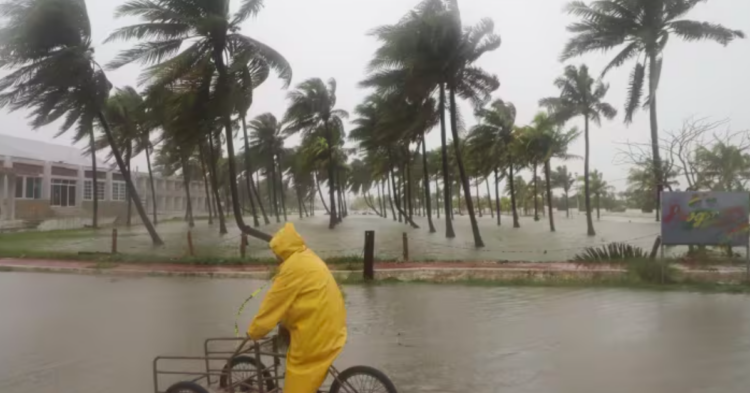Hurricane Milton just hit Florida, and it’s already causing total chaos. Millions of homes and businesses are without power as this storm crashes into the west coast of the Sunshine State.
It made landfall near Siesta Key last night as a category 3 hurricane, and while it’s no longer a category 5 monster, it’s still leaving a path of destruction behind.
Residents in the Sunshine State were advised to take precautions as Milton approached, stocking up on essentials like food, water, and medicine.
Embed from Getty ImagesThe National Weather Service warned of “catastrophic damage” should the hurricane maintain its strength.
Wind speeds were expected to go over 157 mph. Mayor Jane Castor of Tampa Bay wasn’t sugarcoating things either, warning locals, “If you don’t evacuate, you are going to die.”
In the aftermath of Milton’s landfall, over two million homes and businesses are currently experiencing power outages.
Embed from Getty ImagesAreas like Sarasota County, Manatee County, and Pinellas County have been hit the hardest, and officials are concerned that some residents may be without electricity for weeks, impacting daily life and safety.
Before Milton even reached land, 125 homes were reported destroyed, according to Kevin Guthrie, director of the Florida Division of Emergency Management.
Embed from Getty ImagesEyewitness videos have captured the terrifying reality for those in the area, showing buildings damaged and debris scattered across neighborhoods.
While Tampa Bay avoided a direct hit, the surrounding areas were not so fortunate.
Embed from Getty ImagesNumerous tornadoes formed as a result of the hurricane, with tragic reports emerging from St. Lucie County, where two lives were lost due to tornado-related incidents.
Several others have been hospitalized, and the community is reeling from the impact.
Hurricane Milton is being acknowledged for how rapidly it escalated.
Embed from Getty ImagesFrom 60 mph winds on Sunday to a staggering 175 mph by Monday, it is now considered one of the fastest-intensifying Atlantic storms in recorded history.
While the intensity has downgraded to category three, its current strength is still causing quite a lot of challenges for residents.
Tropicana Field, home of the Tampa Bay Rays, sustained damage as the storm ripped off part of its roof.
Embed from Getty ImagesThis venue was intended to serve as a shelter for up to 10,000 evacuees, but the situation has become increasingly chaotic.
Thankfully, there were no injuries reported.
If that wasn’t bad enough, footage of the storm from space shows just how massive and powerful it is.
Embed from Getty ImagesPresident Joe Biden even dubbed Milton the possible “storm of the century.”
Which is… not exactly comforting.
Rescue efforts have been ongoing, but operations in St. Petersburg were temporarily halted due to adverse weather conditions.
Embed from Getty ImagesA crane in the city center collapsed, adding to the list of hazards as the community grapples with the immediate aftermath of the storm.
Flash flooding is another huge concern as heavy rainfall continues to impact the areas.
Embed from Getty ImagesSome residents are stranded, with roadways becoming impassable.
We can only imagine the emotional toll as uncertainty looms and families navigate this disaster.
The power outages have left many residents anxious, especially with officials warning that getting electricity back up and running could take a while — particularly for those living in rural areas.
Embed from Getty ImagesThe thought of being without power for weeks is pretty overwhelming, making an already tough situation even harder for families trying to navigate their day-to-day lives.
Farmers, who play a vital role in Florida’s economy, are also facing some serious challenges thanks to Milton.
Embed from Getty ImagesInitial reports indicate that crop damage could lead to billions in losses, which is a big blow not just for the farmers but also for the state’s agricultural landscape. The long-term impact on these hardworking folks and their livelihoods is something we’re all going to feel.
Many have compared Milton’s severity to past hurricanes like Katrina and Michael.
Katrina, which struck in August 2005, is often regarded as one of the deadliest and costliest hurricanes in U.S. history.
Embed from Getty ImagesIt caused over 1,800 fatalities and inflicted a staggering $125 billion in damage across the Gulf Coast.
The storm’s impact was devastating in New Orleans, where levee failures led to catastrophic flooding. In contrast, while Milton was downgraded to a Category 3 hurricane, its speedy escalation and powerful winds left communities extremely vulnerable.
Hurricane Michael, which hit Florida’s Panhandle in October 2018, serves as another comparison. Michael made landfall as a Category 5 storm, with maximum sustained winds of 160 mph.
Embed from Getty ImagesIt resulted in 59 deaths and over $25 billion in damages.
Hurricane Milton has raised questions about the impact of climate change on hurricane behavior.
Embed from Getty ImagesExperts warn that storms like this are becoming more unpredictable, and this is something we can expect to see continue.
As residents face the aftermath of Milton, climate change and the urgency for hurricane preparedness are clear.
As the hurricane moves out, Florida faces the daunting road to recovery.
Embed from Getty ImagesFirst responders are on the ground, working hard to bring aid and hope to those affected.
While the journey ahead won’t be easy, the spirit of the Sunshine State shines bright, and the people are ready to rebuild and recover!

















































